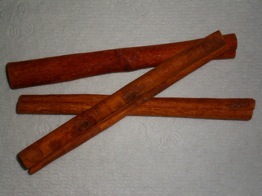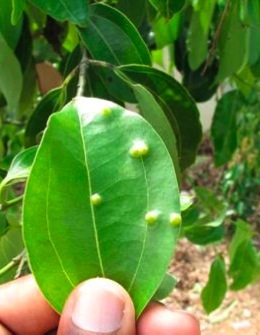INTERACTIONS
2009
Cinnamomum zeylanicum obviously has a major role in interacting with people because of the way we use cinnamon either medicinally or culinary. Lets first, however, look at this plants interaction with other species.
C. zeylanicum can attract some parasitic relationships that have the potential to harm the tree. Some of these species include insects and arthropods found commonly in Sri Lanka. In certain areas of Sri Lanka minute insects attack leaves and cause gall formation, and decrease the leaf oil yield by twenty percent. There are two different types:
-
1.Gall Forming Mites (Erioplytes boisi Gerber) – these mites lay their eggs on or in the leaf tissue and gall formation occurs. The lower surface of the leaves is where galls can be found. They begin as a pinkish color and turn green when mature.
2.Jumping Plant Louse (Trioza cinnamini boelli) – is a very small organism that lays its eggs on the lower leaf surface. Gall formation appears to be due to feeding effects of emerging nymphs.
Other organisms that cause harm to C. zeylanicum are the Clear Wing Moth and the Shoot Borer. Clear Wing moths cause damage to the base of the cinnamon plants when its larvae make holes when feeding. The Shoot Borer causes death of the upper shoots because it feeds on tender shoots of the plants.
Cinnamon has a mutualistic relationship with mycorrhizae, a relationship that can be seen about 90% of the time between plants and fungi. Cinnamon benefits from an increase in water absorption, surface area, and mineral uptake such as nitrogen. The fungus receives sugars from the plant. (Learn more about fungi here)
Photos Top to Bottom
-
1.Cinnamon Leaves
-
2.Cinnamon quills
-
3.Mites cause galls on the leaf tissue
-
4.Galls from the Jumping Plant Louse
Cinnamon and Others
Stats
Interactions? Mutualistic & parasitic
with whom? Insects, arthropods, & humans
provide food? Yes, autotroph
food web? Primary producer

Cinnamomum zeylanicum is an autotroph and synthesizes organic matter from inorganic matter and sunlight. Through the process of photosynthesis, they convert carbon dioxide and water into sugars and simple sugars. Green plants, including cinnamon, are primary producers in any food web since they synthesize and store the energy sources of all other organisms. The other organisms that live in the same habitat with cinnamon benefit greatly from this tree. They may use the tree for a habitat, a place to reproduce, or as a means of nutrition.
Cinnamon has an important association with humans, like mentioned previously. (Plus you cannot forget about all those “cinnamon girls”) To learn more about this plants interactions with us, visit this page on cinnamon’s cultivation and history.



